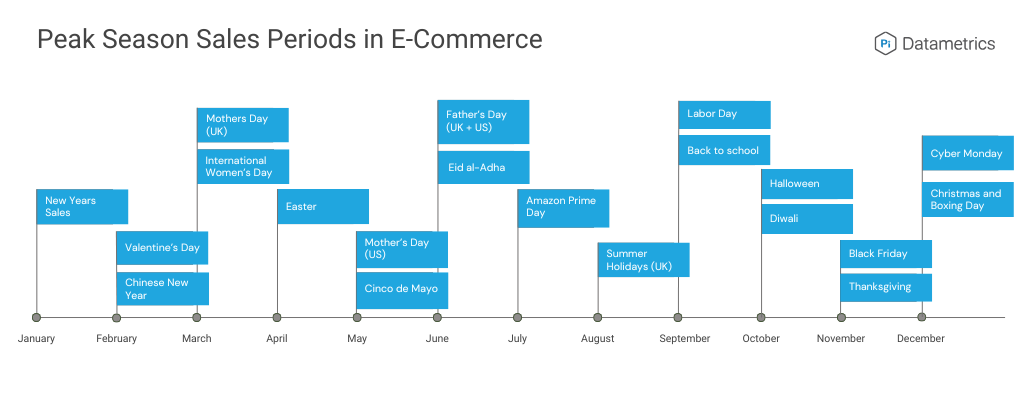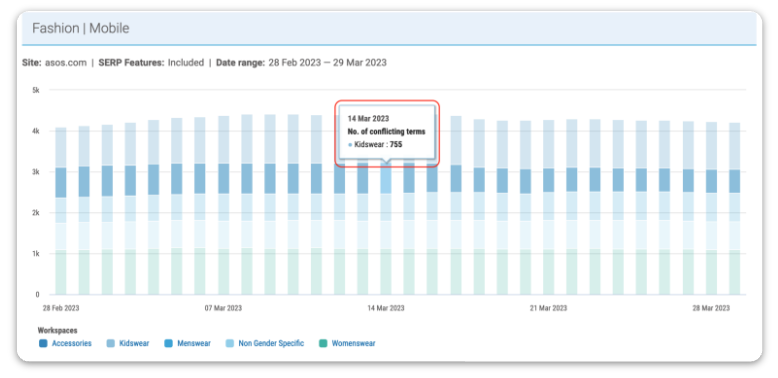Peak Season E-Commerce SEO Playbook: How to Win the Sales Season Search Battle
24 Apr 2025|5 MIN READ
If you’re managing SEO for an e-commerce brand, you already know that peak season isn’t just a traffic surge - it’s a high-stakes revenue opportunity. Whether your peak season is Black Friday or summer, your success depends on what you do before the rush begins. In a recent joint webinar featuring SEO experts Jon Earnshaw from Pi Datametrics and Richard Barrett from our partners Lumar, we explored what it takes to prepare your site for high-performing search visibility during peak season. From keyword cannibalization to technical site tweaks and content timing, this is your complete guide to a successful seasonal SEO strategy.
Why your peak season SEO strategy can’t wait
It’s tempting to treat peak season SEO like a sprint. But in reality, it’s more like training for a marathon - what you do six months ahead can make or break your rankings when it matters most.
E-commerce teams often find themselves scrambling to prepare for peak sales periods like Black Friday or the holiday season just one month before. During the webinar, poll results confirmed this last-minute pattern - but this timeline that can severely limit your ability to drive organic traffic.
Seasonal SEO strategies should start as soon as the previous season ends. Some companies even dedicate entire teams to seasonal planning year-round - a commitment that makes a lot of sense when you realize that peak periods can generate up to one-third of annual revenue.

Managing keyword cannibalization effectively
One of the biggest risks in e-commerce SEO is keyword cannibalization. It’s especially common during sales seasons when lots of content is published to maximise chances of driving revenue, without a clear strategy.
Jon Earnshaw put it plainly:
“Everyone thinks, ‘Let’s create more content for peak,’ but more content without a plan often creates conflict.”
Without planning, your new landing pages or sale hubs may compete with your existing ones. That leads to ranking volatility, confusion, and lost traffic.
So what can you do about it?
1. Identify it
The first step in tackling keyword cannibalization is detection - and automation can save you hours.
Use tools like Pi Datametrics’ Keyword Cannibalization Tool to uncover cannibalization quickly. It automatically scans thousands of terms across your site, instantly flagging cannibalization issues - so you’re not stuck digging through rank data manually.

Pi’s Keyword Cannibalization Tool also shows you:
- How often your top-ranking URL changes for a given term.
- Start, end, and peak positions to track rank movement over time.
- The traffic impact caused by these conflicts over the last 30 days.
This lets you prioritize the fixes that actually matter to performance.
2. Fix it
Once you’ve identified problematic pages, the goal is to consolidate authority and guide Google clearly to the page that should rank. Here’s how:
- Use internal links strategically. Link from lower-priority or related pages to the target page using relevant anchor text. This passes authority and reinforces topical relevance. Canonicalize duplicates if the content must exist in multiple places but only one version should rank.
- Merge or consolidate content when two pages cover similar ground. Choose the better-performing or more comprehensive page as the keeper.
- Redirect pages that no longer serve a purpose or have lost their SEO value - especially if they’re ranking but don’t convert or align with your goals.
3. Prevent it
Avoiding future cannibalization is just as important as resolving it. As you plan seasonal or campaign-driven content, build a habit of auditing for overlaps before hitting publish.
Tips to stay ahead:
- Map keywords to URLs with a simple content-to-keyword matrix. This helps clarify which terms each page targets and prevents overlap across teams.
- Review internal search data. If multiple pages are being found for similar terms, it may signal confusion in your content structure.
- Work cross-functionally. Coordinate with merchandisers, content writers, and dev teams to ensure new seasonal landing pages or sale hubs don’t clash with existing evergreen content.
- Theme content intentionally. For example, instead of launching a new “Black Friday Tech Deals” page every year, build an evergreen hub and update it annually—preserving SEO equity and avoiding duplicate intent pages.
💡 Tip: For more information on how to identify and eliminate keyword cannibalization, check out our previous webinar with Search Engine Journal.
Use historical search trends to pinpoint peak demand
Knowing when and what to publish for peak season is key. By examining how search volume has behaved over the past 12 to 24 months, you can predict when interest in your key categories or products will build, and when it’s likely to peak. This insight is invaluable not just for planning content but also for aligning campaigns, product launches, and stock availability with actual customer demand.
Using historical search data from Pi Datametrics’ Search Volume Timeline, Jon demonstrated the importance of forward planning in competitive categories like Beauty, where he identified that the “nails” category begins rising in March, peaking in July.

Understanding historical consumer search trends allows you to:
- Plan ahead, by making sure you’re able to publish content early enough for Google to index and rank it before demand peaks.
- Prioritize the categories which drive the most traffic and therefore revenue.
- Spot emerging trends so you can get ahead of demand.
With the right data, your content strategy becomes predictive - not reactive.
Technical SEO tips to power your peak season performance
Beyond content, your technical foundation must be solid to capitalize on seasonal demand. Technical SEO will always do the heavy lifting, especially when traffic surges in peak seasons.
Here’s how to reinforce your foundation ahead of peak season:
Internal linking and site architecture
Many brands launch new landing pages for sales events, such as “Black Friday Deals.” which are then buried deeper into the site architecture or removed entirely post-peak season. This can cause a whole host of problems.
Richard suggests a smarter approach:
- Keep seasonal pages evergreen. Rename them something like ‘Special Offers’ or ‘Hot Buys’ to preserve and maintain authority year-round.
- Maintain internal links, especially from high-authority pages like the homepage or the primary navigation.
- Avoid disrupting page depth. If a page suddenly moves from five clicks away to one, it disrupts the site structure and confuses Google.
Minimise soft 404s
A soft 404 occurs when a page technically loads (status code 200) but signals to Google that it shouldn’t exist - usually with content like “out of stock” or “page not found.”
These pages waste crawl budget and lose link equity. Worse, they often go unnoticed. Instead of letting these ghost pages linger:
- Redirect them to the next best match.
- Avoid generic “product no longer available” pages - they offer no value
- Avoid redirecting to the homepage - Google sees through this!
Protect your backlink value
You’ve spent months building backlinks to your Black Friday page. Then December hits, and you take it down. What happens? Google deindexes it. Next year, you’re starting from zero. Not an ideal scenario.
A better solution is to maintain the page year-round. Update the messaging, keep it linked internally, and let it accumulate authority. When next year’s sale returns, you'll be ready with a page which already has value, authority, and rank history.
Final takeaways
Jon’s key takeaway: Avoid unnecessary content conflicts during seasonal planning. Optimize what you already have before creating more. Before you publish a single piece of content, look at your existing ecosystem. Are you supporting what already performs, or creating conflict? Use tools, spot patterns, and act with intent. In SEO, clarity is what drives results—and revenue.
Richard’s key takeaway: Don’t treat sales pages as one-offs. Build out persistent landing pages that evolve, so you’re not starting from zero every year. Reuse, redirect, and refresh strategically. Let SEO gains compound over time instead of starting from scratch every year.
As you head into your next peak, whether it’s Black Friday, summer sales, or January discounts, remember this: good SEO isn’t just about ranking higher. It’s about building smarter. Planning earlier. And keeping what you’ve earned.
Want more insights from Jon and Richard?
This post is based on insights shared in a recent e-commerce focused webinar. If you're prepping for Black Friday SEO, or planning your broader seasonal SEO strategy, we highly recommend watching the full session for even more data-driven advice and live examples.
Watch the full webinar now 👇🏼
Never miss a post
Join our mailing list and have our SEO news delivered straight to your inbox.


